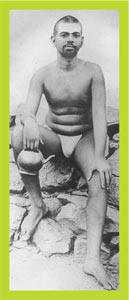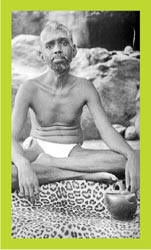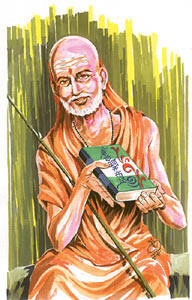Ramanamaharishi19
சக்தி விகடன் -
28 Dec, 2010
2010-12-28-part1-2
![]()
Gambhīram
Sēṣaiyar
is a Telugu Brahmin. He belongs to Mulukki Nadu near Hyderabad. His
ancestors like Akkaṇṇā,
Mādaṇṇā…served as ministers to Sultan. Appreciating their services,
Sultan gave them a title, ‘Gambhīram.’
Gambhīram:
Sēṣaiyar
belongs to that illustrious lineage.
Being a Rama devotee, he chanted the name of Rama. Vivekananda’s
lectures and books were magnetic to him.
He performed Hata Yoga as recommended by Vivekananda. Attracted
to Sri Ramaṇa,
he shared with him his spiritual thirst, Pranayama and other pursuits.
Bālaswāmy known later as SriRamaṇa
Maharishi understood his interest.
Sēṣaiyar
was not a Tamil; therefore, Periyava explained his tenets in prose form
instead of poetic form for his easy understanding. Those explanations
became books by Gambhīram
Sēṣaiyar
from his notes taking of what Periyava told him.
 Because
of it, Bālaswāmy’s conversations compact with substance and ease of
explanations, the world received. The Janani’s fame shines because of
it. The intelligent and
able Jñāṉi’s proximity with the true and loving devotees bore fruits.
These conversations were of great help for the future devotees of Sri
Ramanamaharishi.
Because
of it, Bālaswāmy’s conversations compact with substance and ease of
explanations, the world received. The Janani’s fame shines because of
it. The intelligent and
able Jñāṉi’s proximity with the true and loving devotees bore fruits.
These conversations were of great help for the future devotees of Sri
Ramanamaharishi.
Hata Yoga has many categories.
There is a progressive advancement between stages. Only by the
practice of Hata Yoga, one can discover “Who am I?” (This is refuted by
Ramana.) It declares that by analyzing closely the enquiry into God, one
can obtain liberation. Hata
Yoga is the treasure of Bharata continent. Since the advent of Sanatana
Dharma, Hata Yoga was in practice. Hata Yoga has eight divisions, Yoga Aṣṭāṅgam.
What are they?
To begin with, there are two prerequisites: Iyamam and Niyamam (Yama and
Niyama): Good behavior and good Gunas, courteous speech, anger-free
words, truth telling, no backbiting, food restrictions, moderate sleep,
Brahmacharya, seeking solitude…
Third, the Asanas. Diseases
of the body are inimical for search of God. Self-enquiry will not be
possible. Disease affects the mind. Disease-preventive measures involve
Asanas (postures). These
postures are important.
These postures help keep good digestive tract, assure strength of limbs
and neck, ensure proper and adequate blood flow to the brain, and
maintain proper nerve function. From the opening at the end of the spine
to crown of the head, there are various Chakras. For their proper
functioning, the body and its functions should be healthy. For the
stimulation of these Chakras, these postures are of great help. The
above are according to Hata Yoga. These postures help control the mind.
Fourth, Hata Yoga teaches Prāṇāyāma.
The breath is taken via the left nostril, held and exhaled by the
right nostril. Then, the
breath is inhaled via the right nostril, held and exhaled by the left
nostril. The aspirant should seek the help of an expert and do the
breathing exercises like inspiration, retention and expiration on a
timed scale. Hata Yoga insists on correctly performing breathing
exercises.
Because of the exercises, the wandering mind becomes quiescent and
steady. Breath and mind are connected. When the mind is excited the
breathing is out of whack. This precipitates a negative feedback on the
mind resulting in vicious cycle. For the quiescent mind, breath control
of many types is essential. Proper breathing exercise helps proper blood
flow.
Hata Yogam tones down the excitability, helps with normal blood flow and
assures to optimal body functions.
Fifth, Hata Yoga explains Pratyāhāra
(the
withdrawal of the senses from the objects of sense).
Uninterrupted Mantra Japa helps quieten the mind. Mantra Japa is like a
chain, which when held by the elephant’s trunk stops the animal from
moving the trunk. Likewise, Mantra Japa quietens the mind. The Mantra
japa should be learnt from a Guru. Pratyāhāra helps lessen or eliminate
anger, agitation, hatred, desire…
Dhyāna
(meditation) comes after
Dhāraṇā
(steadiness). Dhyana is not concentration of the mind. It is not
one-pointed. When the mind is one-pointed and Dharana path is followed,
Vikṣepa (blossoming,
விகசிபம்)
is produced (while pursuing the path of Dharana). After a long practice,
coming suddenly under the influence of the mind, it is knowing, ‘I am
this.’ Forgetting the burden, mind enters itself and remains there. The
form of the deity being the object of meditation at the beginning,
realization takes place that the mind’s form is that of the deity itself
and the mind remains merged in the form of the deity.
Or, it remains immersed in the great formless effulgence.
Mind is not under its control usually. Now it entered in to a greater
entity (Āṉmā).
The merger of the mind with
Āṉmā
results
 in
realization and the mind stays bonded to
Āṉmā.
Now and then the mind separates from Āṉmā,
participates in worldly activities and goes back to Āṉmā
to remain bound to it. It is like the married woman desirous of
consorting with her husband (time and again), the mind desires and
consorts with Āṉmā
to remain bound with it.
in
realization and the mind stays bonded to
Āṉmā.
Now and then the mind separates from Āṉmā,
participates in worldly activities and goes back to Āṉmā
to remain bound to it. It is like the married woman desirous of
consorting with her husband (time and again), the mind desires and
consorts with Āṉmā
to remain bound with it.
To those who are deep into meditation (Dhyāna), the world affairs look
different. Exiting that union for changing clothes, eating or conversing
with others, it can renter Dhyana.
That being so, some faculties are awakened.
Nature’s movements and people’s ins and outs are apparent. These deep
meditators can help those with grief and are models of mercy. That mercy
helps the needy with love and concern. The benevolent help strengthens
their Dhyana. They remain deep in Dhyana.
The eighth is Samadhi, as spoken in Hata Yoga.
Samadhi is the state, forgetful of ‘I and
Ātmā.’
It is impossible to explain it further. It is a subtle state
beyond words. It is ‘I’-less state. It is a state of forgetting. The
practitioners do not know what they do. Nothing remains in memory. They
do something. But, whatever they do, it is always right. It is a
wonderful artifice. It is a
state of merger with God. Hata Yoga is an Ambrosial Vessel. Not all can
attain this kind of realization.
Virtuous and sharp pupils will gravitate to the great Gurus, who in the
manner of a magnet attract good pupils. They are a cause for
celebration. The intelligent pupils question the Guru; the appropriate
answers and the thought processes stimulated by them in the Guru make
the Guru-pupil interactions fruitful. The feeling of satisfaction from
imparting knowledge to the most deserving finds fulfilment in the Guru.
Gambhīram Sēṣaiyar’s
knowledge of Hata Yogam and his deep opinions appealed to Bālaswāmy,
who needed a pupil conversant with Hata Yoga for (postulation and)
elaboration of ‘Who Am I?’
Bālaswāmy told Gambhīram Sēṣaiyar, “Hata Yogam is not necessary.
Āṉma
enquiry itself is enough for enquiry into ‘Who Am I?’
Sēṣaiyar: “Hata Yoga is not my recommendation or my initiative. That was
mentioned by Vivekananda.
It is not his initiative either.
It is coeval with Sanatana Dharma. They were observed with great
care and efficiency. Many subtleties were established in Hata Yoga and
spread by Gurus throughout the country.
Prāṇāyāma is not merely inspiration with Kumbhaka (retention) and
expiration. There are very many variables.
Yama and Niyama dictate what to eat, what not to eat and when not
to eat.
Sēṣaiyar said with some unhappiness, “There are restrictions on how much
one can eat. Gurus were clear in their recommendations. If you declare
Hatayog is not necessary, that proposition should be opposed in a proper
way. “
Bālaswāmy explained it in a conversational style. Though Sēṣaiyar of
Telugu origin had poetic abilities and published multiple poetic books,
Periyava’s explanation was given in simple text with diligent care for
the comprehension of the Telugu man. That conversational textual
explanation was translated in many languages for the benefit of many
people.
Bālaswāmy, the future Ramana said with clarity, “For the beginners,
Hatayoga is good, but will not accomplish clarification of the enquiry
of ‘Who Am I?’ “
Let us obtain Darsan
Images: K.Rajasekharan
Sakti Vikatan December 28, 2010
part 2

Kanchi Mahan, the deity of compassion.
Akhila Kārttikēyan
the relative of ‘Pradoṣam
Māmā’
said, “Bodily inconvenience, wind, rain, day or night, inconvenient
time… are immaterial for Pradoṣa Māmā if it dawned on him to have Darśan
of Maha Swamy. The Mutt was about four km from his house. He thought it
was a rare grace to obtain Darśan of Periyava.
 ‘Pradoṣam
Māmā’s’
natal name was Venkatraman, an employee of the Indian Railways in Salem
and Madras. Every Pradoṣam (evening), he obtained Darśan of Periyava.
Once, Periyava himself observed, “Aren’t you the one that comes every
Pradoṣam (evening).” Since then the word Pradoṣam got stuck to his name.
Later, he lived in Kanchi. The stories narrated by Karthikeyan are
exhilarating.
‘Pradoṣam
Māmā’s’
natal name was Venkatraman, an employee of the Indian Railways in Salem
and Madras. Every Pradoṣam (evening), he obtained Darśan of Periyava.
Once, Periyava himself observed, “Aren’t you the one that comes every
Pradoṣam (evening).” Since then the word Pradoṣam got stuck to his name.
Later, he lived in Kanchi. The stories narrated by Karthikeyan are
exhilarating.
Once, there was a fierce downpour.
The Government issued a weather alert.
He ignored the warning. Pradoṣam
Māmā was given protection by the grace of Mahāperiyava on his 4km return
trip back home from Darśan of Kānchi Periyava. How could it be anything
else?
Pradoṣam
Māmā on his way to Mutt saw Tiruvarata
Ōthuvār
with his family and a motley crowd of devotees singing Tiruvāsaka
poems and raising slogans like ‘Long live Namasivaya,’ and Long Live
Lord’s feet.’ Pradoṣam Māmā was unhappy, because their invocations
drowned out his usual invocation: ‘Aruṇāchala
Śiva.’
Pradoṣam
Māmā asked the fellow devotees to chant ‘Tiruvarata
Ōthuvār
as instructed by Ramanar. He insisted everyone including Tiruvarata
Ōthuvār
to chant ‘Aruṇāchala
Śiva.’
He knew that ‘Aruṇāchala
Śiva’
is no other than Namasivaya.
All came to the Mutt and had Darśan of Periyava.
Kānchi
Mahāṉ
asked to see Ōthuvār, a little while after Ōthuvār took leave of him.
The people there told him he left the place. Mahāperiyava gave a
book to Pradoṣam Māmā and asked him to find out from Ōthuvār the year of
publication of Thiruvāsakam.
It came to that he had to go to Chennai to carry out the order of Kānchi
Mahan and locate Ōthuvār for the information. He took a friend to locate
him. He went to the office he used to work before his retirement.
A coworker noticing Māmā
said, “What a surprise. I was thinking of sending you a letter to report
to the office to take your salary arrears amounting to a thousand
rupees. If you have not come by here today, that check would have been
sent back to Accounts Section.
Getting that money back to you is difficult.”
Those days, one thousand rupees are big money. Pradoṣa Māmā
felt that Mahā
Periyava carried out this play in his gracious offering of blessings.
It did not end there.
Locating Ōthuvār in Chennai, he asked him about the publication details.
He did not know. Pradoṣa
Māmā
gathered the sought-after information through others and went back to
Kānchi Mutt. Periyava
hearing all he said, asked him to read the first few pages in the book.
Pradoṣam Māmā opened the book and was shaken like a leaf in a brisk
wind seeing Siva Purana starting with the invocation ‘Long Live
Namasivaya’ (நமசிவாய
வாழ்க).
‘Aruṇāchala Śiva and Namaśivāya are non-different. This way, Periyava in
a subtle way made pradoṣa Māmā realize the non-difference.
Akilā Kārttikēyan narrated an incident involving Tiruppāvai-Tiruvempāvai.
That was 1949 when Mahāperiyava was in Tiruvidai Maruthūr.
A woman of higher caste came with a book every day, sang songs
before Periyava and left. One day, Periyava queried Ramamurthy, “Do you
know the songs of Tiruppāvai and Tiruvempāvai sung by the woman.”
He did not understand his query.
Periyava sent the man to Devarāja
Bhāgavathar
to find out whether people on the outside would sing along Tiruppāvai-Tiruvempāvai.
Ramamurthy met with Bhagavathar, who said, “No one knows these poems. No
one will sing.”
Ramamurthy informed Periyava about this. Immediately, Tiruppāvai-Tirvumpāvai
Mānādu
(conference) was organized by Kanchi Mahan.
At the beginning of the month of Mārgazhi, Periyava sitting on the
elephant with the book and a light along with Ramamurthy and Kannan
ordered them to sing the songs during the procession along the four
streets adjoining Sri Mahāliñga
Swami Temple. With the
blessings of Periyava, the Tiruppāvai-Tiruvempāvai
conference took place with great success.
Since then, musical rendering of the poems took place. K.V.J, the Tamil
exponent and others gave discourses on the songs. Periyava asked
Uththandaraman, the official in charge of Hindu endowments Board to
institute the rendering of Tiruppāvai-Tiruvempāvai
in all temples in the month of Mārgazhi every year.
Heeding to the order of Periyava, T.K. Pattammal, M.L. Vasanthakumari,
Ariakkudi Ramanuja Iyengar…spread the awareness by singing Tiruppāvai-Tiruvempāvai.
Sometime later, Periyava sporting a mischievous smile addressed Ramamurthy,
“The high-caste woman’s songs, nobody would sing: that is what you said.
Anybody singing now?”
Thinking of Periyava, as
Īśvara
Rūpam,
he said, “There is nothing that can’t be done, if Periyava thinks of
it.”
Once in Tanjore, pointing to Ramamurthy, Periyava said smilingly, “Now
Tiruppāvai-Tiruvempāvai
is sung all over by all. All that credit goes to Ramamurthy.”
Darśan will Continue

